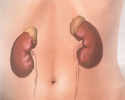Hemodialysis access - self care
Kidney failure - chronic-hemodialysis access; Renal failure - chronic-hemodialysis access; Chronic renal insufficiency - hemodialysis access; Chronic kidney failure - hemodialysis access; Chronic renal failure - hemodialysis access; Dialysis - hemodialysis access
Vascular access (often called just "access") is needed for you to get hemodialysis. Using the access, blood is removed from your body, cleaned by a dialyzer, then returned to your body.
Usually the access is put in a person's arm. But it can also go in your leg. Depending on the type of access, it takes a few weeks to a few months to get an access ready for hemodialysis.
Taking good care of your access helps make it last longer.
Prevent Infection in Your Access
Keep your access clean. Wash the access with soap and water every day to decrease your risk of infection.
Do not scratch your access. If you scratch open your skin at the access, you could get an infection.
To prevent infection:
- Avoid bumping or cutting your access.
- Do not lift anything heavy with the arm with the access.
- Use your access for hemodialysis only.
- Do not let anyone take your blood pressure, draw blood, or start an IV in the arm with the access.
Keep Blood Flowing Through Your Access
To keep blood flowing through the access:
- Do not sleep or lie on the arm with the access.
- Do not wear clothes that are tight around the arms or wrists.
- Do not wear jewelry that is tight around the arms or wrists.
Checking Your Access
Check the pulse in your access arm. You should feel blood rushing through that feels like a vibration. This vibration is called a "thrill."
Have the nurse or technician check your access before every dialysis.
When to Call the Doctor
Contact your health care provider if:
- You have any signs of infection, including redness, pain, pus, drainage, or you have a fever over 101°F (38.3°C).
- You do not feel a thrill at your access.
References
National Institute of Diabetes and Digestive and Kidney Diseases website. Hemodialysis. www.niddk.nih.gov/health-information/kidney-disease/kidney-failure/hemodialysis. Updated January 2018. Accessed September 11, 2023.
National Kidney Foundation website. Hemodialysis access. www.kidney.org/atoz/content/hemoaccess. Updated 2015. Accessed September 26, 2023.
Yeun JY, Young B, Depner TA, Chin AA. Hemodialysis. In: Yu ASL, Chertow GM, Luyckx VA, Marsden PA, Skorecki K, Taal MW, eds. Brenner and Rector's The Kidney. 10th ed. Philadelphia, PA: Elsevier; 2020:chap 63.
Review Date: 8/28/2023
Reviewed By: Walead Latif, MD, Nephrologist and Clinical Associate Professor, Rutgers Medical School, Newark, NJ. Review provided by VeriMed Healthcare Network. Also reviewed by David C. Dugdale, MD, Medical Director, Brenda Conaway, Editorial Director, and the A.D.A.M. Editorial team.


